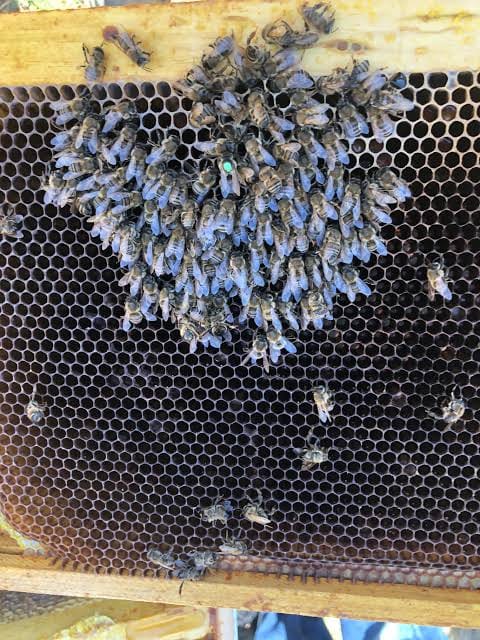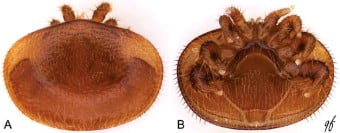If you are inspecting your hives regularly, you can usually see the end coming. When a colony starts to fail, it can be challenging to figure out why, let alone solve the issue.
So, what can a beekeeper do to help their bees?
If you notice there is something not right with your colony, you should absolutely try to figure out what it is. It’s much easier to solve the issue if you can identify it.
Unfortunately, not all new beekeepers are skilled enough to do this, heck, even experienced beeks struggle sometimes. Fortunately, there are a few things you can do that will generally help an ailing colony no matter what their issue is;
1. Reduce entrance and hive cavity.
If you don’t already have an entrance reducer on your hive, put one on. A weak colony will be extremely vulnerable to robbing from other colonies and wasps.
You should also reduce the hive cavity so that your bees can regulate their temperature more easily.
To do this, you need to determine which combs they are still using and remove the ones they aren’t. Undefended empty combs will allow for wax moths and hive beetles to breed out of control. Your bees expend a lot of energy defending those combs to keep the pests out.
An empty comb will have nothing stored in it (no honey, brood or pollen).
If you see combs with honey, pollen or brood in them, you should leave them.
The exception would be if your colony has shrunk significantly and you have several supers of honey, in that case I would harvest some of the honey to reduce the risk of robbing.

2. Feed them.
Many problems in the hive are exacerbated by a lack of food. If your bees don’t have honey, they won’t have the energy to fight whatever is ailing them.
Additionally, a queen will not lay well if your hive does not have the food stores to support the population.
As your colony’s workforce shrinks, so does its ability to manage its ailments and protect itself! When a colony starts to do poorly, adequate food stores is the first thing I check.
If the hive looks like its taking a dive and they don’t have any honey, start by feeding them sugar water and see if they improve.
However, feeding a weak hive can be tricky because sugar water can draw pests and a shrinking, sick hive will not be able to fend them off. Make sure you feed in such a way that your bees can defend it.
3. Add capped brood.
There are two main hurdles to a colony recovering: food and population.
When they have plenty of both, they can usually overcome problems on their own. When your colony begins to shrink, they will almost always benefit from a boost in population.
If you have a second, healthy colony you can steal a frame of capped brood from them and give it your weak hive. Make sure you find a frame with mostly capped brood (like in the photo below).
Uncapped brood will stress your weak colony more because those young larvae will demand food and nurse bee resources your hive probably does not have.
A frame of capped brood will just need to be kept warm until the brood hatches. Then your queen will have a fresh batch of nurse bees that may allow her to lay more eggs and start bring the population up again.
Be careful not to weaken a healthy colony by taking too much and similarly you should not give a weak colony too much brood at once from another hive because they probably don’t have the resources to support that many new bees.
When adding the frame, make sure all the adult bees from the other hive have been swept off before putting it in your weak hive. While brood from another colony will be adopted, the adult bees will most likely fight each other.

4. Treat for mites?
Even though I am a treatment free beekeeper, there are times when mites will overwhelm bees and action needs to be taken. The reality is that mites almost always play a role in a crashing hive.
Sometimes feeding and adding brood will strengthen a colony enough to resolve the out of balance mite load on their own, but sometimes it is not enough. If your colony has a high mite count, you might want to do something about it in addition to the above.
You’ll need to decide if your mite issues stem from weak genes or if there is an outside factor involved. So, while I am someone who subscribes to the survival of the fittest / treatment free philosophy, I believe there is a grey area.
For example, what if your bees were poisoned, their population took a hit and now mites have gotten out of balance?
You can hardly blame the genetics of your queen in this instance. For that reason, I sometimes do treat for mites by shaking powdered sugar on them.
It helps the mite drop and combined with the above can get the colony back to a place where they are strong enough to fight the mites on their own.
If the bees are genetically weak and require regular mite treatments to survive, a powdered sugar treatment will do little to help, instead I recommend requeening with a queen that came from a treatment free breeder.
5. Check the queen.
First of all, make sure you have a queen. Maybe the reason for your hive’s decline is that they are queenless. Second, if you suspect a brood disease is present, requeening to create a break in the brood cycle sometimes corrects the issue. Requeening is something I do only after all other methods have failed and only if there is still a reasonable bee population left to support her. Once a hive’s population dips too low, their chance of bouncing back is so slim it usually is not worth buying a queen.
Summary
It should be noted that these interventions are listed roughly in the order that I would implement them when faced with a weakened hive. First, I reduce the entrance and begin to feed the bees. Then, if their population is low, I will also add a frame of capped brood. If after two weeks I see no improvement and I think mites are playing a role, I consider some form of mite treatment and/or requeening.
Credit: https://www.facebook.com/kirimirihoney
5 WAYS TO HELP A FAILING HIVE
